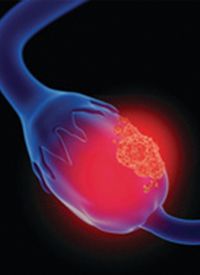Article
Olaparib Plus Bevacizumab Maintenance Therapy Provides OS Benefit in Advanced HRD-Positive Ovarian Cancer
Author(s):
Maintenance olaparib plus bevacizumab following first-line standard-of-care treatment improved overall survival in patients with newly diagnosed advanced ovarian cancer, particularly those with homologous recombination deficiency.

Maintenance olaparib (Lynparza) plus bevacizumab (Avastin) following first-line standard-of-care treatment improved overall survival (OS) in patients with newly diagnosed advanced ovarian cancer, particularly those with homologous recombination deficiency (HRD), according to final OS results from the phase 3 PAOLA-1/ENGOT-ov25 trial (NCT02477644) presented at the 2022 ESMO Congress.1
“These data confirm the addition of olaparib to bevacizumab as a standard of care for HRD-positive patients in this setting and the importance of precision medicine and biomarker testing to guide treatment decisions,” Isabelle L. Ray-Coquard, MD, PhD, a medical oncologist at Centre Léon Berard Université Claude Bernard in Lyon, France, said during a presentation of the data.
After a median follow-up of 61.7 months (range, 57.5-67.0) in the olaparib arm and 61.9 months (range, 58.1-66.8) in the placebo arm, median OS in the intent-to-treat population was 56.5 months vs 51.6 months, respectively (HR, 0.92; 95% CI, 0.76-1.12; P = .4118). Moreover, OS rates at 5 years were 47.3% with the addition of olaparib compared with 41.5% with placebo.
In patients with tumors positive for HRD, the addition of olaparib to bevacizumab maintenance therapy reduced the risk for death by 38% (HR, 0.62; 95% CI, 0.45-0.85), with 5-year OS rates of 65.5% with the combination regimen and 48.4% with placebo. This benefit was consistent across patients who harbored a BRCA mutation (5-year OS rates, 73.2% vs 53.8%, respectively; HR, 0.60; 95% CI, 0.39-0.93) and those who did not (5-year OS rates, 54.7% vs 44.2%; HR, 0.71; 95% CI, 0.45-1.13). However, no benefit was seen in HRD-negative patients (5-year OS rates, 32.3% vs 25.7%, respectively; HR, 1.19; 95% CI, 0.88-1.63).
As of the final analysis, adverse events of special interest in the olaparib and placebo groups included myelodysplastic syndrome/acute myeloid leukemia/aplastic anemia (1.7% vs 2.2, respectively), new primary malignancies (4.1% vs 3.0%), and pneumonitis (1.3% vs 0.7%).
“Incidence of MDS/AML and new primary malignancies remained low and balanced between arms,” Ray-Coquard said.
In the randomized, double-blind, international phase 3 trial, patients were randomized 2:1 to receive either 300 mg olaparib tablets twice daily (n = 537) or placebo (n = 269) for up to 24 months. All patients received 15 mg/kg bevacizumab every 3 weeks for up to 15 months.
Progression-free survival (PFS) served as the primary end point. Secondary end points included time to second progression (PFS2) and OS.
To be eligible for the trial, patients had to have newly diagnosed, International Federation of Gynecology and Obstetrics (FIGO) stage III to IV, high-grade serous or endometrioid ovarian, fallopian tube and/or primary peritoneal cancer, and a response after first-line platinum-taxane chemotherapy plus bevacizumab. First-line treatment included upfront or interval surgery and platinum-taxane–based chemotherapy plus 2 or more cycles of bevacizumab. Patients were eligible regardless of surgical outcome or BRCA mutation status.
Patients in the olaparib arm had a median age of 61 years (range, 32-87). In total, 47% of the olaparib group had HRD positivity, including those with (29%) and without (18%) BRCA mutations. Moreover, the majority of those who received olaparib underwent upfront surgery (50%), with 54% of the arm reporting no evidence of disease.
In total, 19.6% of patients in the olaparib arm (n = 105) and 45.7% of patients in the placebo arm (n = 123) were receiving a PARP inhibitor during any subsequent treatment.
In the primary analysis of the trial, after a median follow-up of 22.9 months, median PFS with olaparib plus bevacizumab was 22.1 months compared with 16.6 months with placebo plus bevacizumab (HR, 0.59; 95% CI, 0.49-0.72; P <.001). In HRD-positive patients, median PFS with olaparib vs placebo among those with a BRCA mutation was 37.2 months vs 17.7 months, respectively (HR, 0.33; 95% CI, 0.25-0.45), and was 28.1 months vs 16.6 months (HR, 0.43; 95% CI, 0.28-0.66) among patients who did not have BRCA mutations.2
In the final analysis, median PFS was 46.8 months with olaparib compared with 17.6 months with placebo (HR, 0.41; 95% CI, 0.32-0.54), with 5-year PFS rates of 46.1% vs 19.2%, respectively.1
References
- Ray-Coquard IL, Leary A, Pignata S, et al. Final overall survival (OS) results from the phase III PAOLA- 1/ENGOT-ov25 trial evaluating maintenance olaparib (ola) plus bevacizumab (bev) in patients (pts) with newly diagnosed advanced ovarian cancer (AOC). Ann Oncol. 2022;33(suppl 7):LBA29. doi:10.1016/j.annonc.2022.08.025
- Ray-Coquard IL, Pautier P, Pignata S, et al. olaparib plus bevacizumab as first-line maintenance in ovarian cancer. N Engl J Med. 2019;381(25):2416-2428. doi:10.1056/NEJMoa1911361









